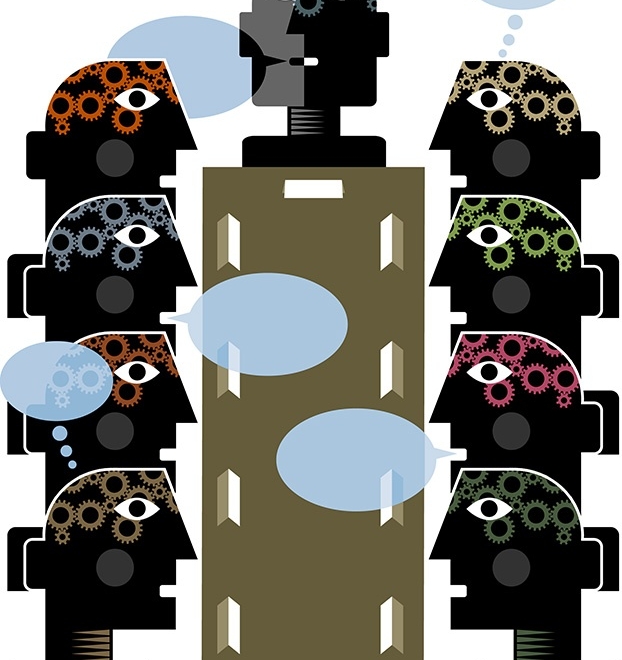Should AI Have a Seat in the Board Room?

A set of three ‘Deep Fundamentals’ is creating new and deepening convergences across the global marketplace. The pace of change continues to accelerate, network connectivity continues to spread, and a constant stream of new knowledge is coming out of human and technology sources.
As we look closely at the explosion of data and artificial intelligence (AI) in particular, we see technology growing smarter at an almost alarming rate, in some cases displacing human knowledge professionals. Consequent market shifts and power shifts require that we take the time to consider how humans and technology can (and must) become an integrated entity.
AI as Frenemy
We begin this consideration by laying out the fundamental belief that the most productive profile of convergence has human and machine partners each bringing unique abilities to the strategy space. Humans bring passion, intuition, relationship, and a capacity to think in ambiguous situations. AI, deep learning and cognitive automation enable us to consume and ingest huge, compounding amounts of data, and apply learned heuristics to optimize our corporate activities.
Deputy Defense Secretary Bob Work has articulated the scenario in which technology and humans work in concert to craft and execute on strategy.
“The real bleeding edge of innovation is…human-machine collaborative networks. It is using artificial intelligence (AI) first and foremost to help humans make decisions…The whole vision of the offset is to make the human better, not to make the machines better…to allow humans to make better decisions, to perform better…and to be more effective.”[1]
While he was speaking in the context of the military’s Third Offset Strategy, this shift to a concerted human/machine solution space has the capacity to elevate productivity and competition in virtually every other public and private sector. In hospitality, for example, robots are transforming the guest experience by acting as ‘smart’ porters.[2] And automated financial counsel and wealth guides are helping financial institutions to enhance their solutions.[3]
In this construct, technology augments our conceptual and analytical operations, and elevates our capacity to think through problems to generate deeper insights. It acts like a collision-warning sensor, which beeps to alert us if our car is too close to something that may be out of our range of vision. It is not a replacement for the driver – it is an enhancement to the driver’s vision.
Elevating Outcomes in the Boardroom
Even the most sophisticated automation cannot replace human innovators and entrepreneurs. What it can do is stimulate us to create new insights, challenge traditional thinking, and reframe our understanding. And with the amount of change, connectivity and data production reshaping the marketplace, it’s more important than ever for us to tap into those capabilities.
For boards of directors in particular, man/machine collaboration offers a greater level of oversight and foresight than ever before – which is more needed than ever before. As they work to advance the organization and protect its value, the board must steer ahead of market shifts. It requires these strategists to be fully engaged in a continuous cycle in which oversight feeds foresight (strategic planning), and foresight serves to make oversight proactive.
The task of managing immediate considerations of compliance and ethics while pausing to stand in the future to direct and transform the organization toward advanced value can stress resources. By integrating AI into that cycle, the board can ingest, contextualize and act on information faster and with a higher degree of accuracy. In other words, machine learning allows the board members to “make better decisions, to perform better…and to be more effective.”
In an ideal boardroom solution space, people frame the questions and engage smart technologies in empowering a smoother drive toward a strategic outcome. It creates a knowledge ecosystem with a clear human-machine division of labor in which each collaborator brings their unique capabilities to the table where they can work together seamlessly.[4]
Great opportunity exists in an environment where AI, deep learning and cognitive automation enable hyperconnected human-to-human knowledge discovery, creation and sharing. But don’t lose sight of the fact that these smart technologies are becoming as available to your competitors as they are to you. Your advantage lies in how you embrace and leverage those technological resources to inform strategic oversight and foresight.
Contact us for the experience and knowledge you need to prepare to take advantage of this ongoing shift.
It’s time to raise productivity in the board room by giving AI a seat at the table.
{{cta(‘c254ce44-075c-42d8-8fb5-4887c026f5c7’)}}
[1] People, Not Tech: DepSecDef Work On 3rd Offset, JICSPOC, Breaking Defense, February 09, 2016
[2] http://www.savioke.com
[3] Artificial Intelligence Use in Financial Services, BITS, April 2015
[4] Designing the Machines That Will Design Strategy, HBR, April 18, 2016
- Categories
- Technology & Innovation Readiness


 About the Authors
About the Authors